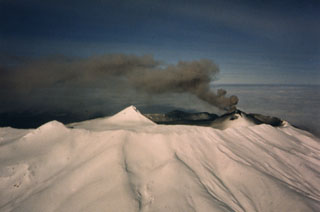Report on Akutan (United States) — August 1986
Scientific Event Alert Network Bulletin, vol. 11, no. 8 (August 1986)
Managing Editor: Lindsay McClelland.
Akutan (United States) Ash plumes from caldera cinder cones
Please cite this report as:
Global Volcanism Program, 1986. Report on Akutan (United States) (McClelland, L., ed.). Scientific Event Alert Network Bulletin, 11:8. Smithsonian Institution. https://doi.org/10.5479/si.GVP.SEAN198608-311320
Akutan
United States
54.134°N, 165.986°W; summit elev. 1303 m
All times are local (unless otherwise noted)
On 30 June at 1840, Reeve Aleutian Airways captain Lee Goch saw gray-black ash emission from the active cinder cone in the caldera. Weather clouds just above the summit were discolored by the ash. Fresh-looking ash had been deposited on the upper N, NW, and W flanks. No additional reports of activity have been received since the end of June.
Geological Summary. Akutan contains a 2-km-wide caldera with a large cinder cone in the NE part of the caldera that has been the source of frequent explosive eruptions and occasional lava effusion that covers the caldera floor. An older, largely buried caldera was formed during the late Pleistocene or early Holocene. Two volcanic centers are located on the NW flank. Lava Peak is of Pleistocene age, and a cinder cone lower on the flank produced a lava flow in 1852 that extended the shoreline of the island and forms Lava Point. The 60-365 m deep younger caldera was formed during a major explosive eruption about 1,600 years ago and contains at least three lakes. A lava flow in 1978 traveled through a narrow breach in the north caldera rim almost to the coast. Fumaroles occur at the base of the caldera cinder cone, and hot springs are located NE of the caldera at the head of Hot Springs Bay valley and along the shores of Hot Springs Bay.
Information Contacts: J. Reeder, ADGGS.

